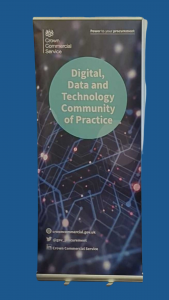CCS Digital Data and Technology (DDaT) Communities of Practice (CoP) Event
OR
Why are Carbon Reduction Plans important? (from a supplier’s perspective)
 Last week Rowe were fortunate to be invited to attend, and take part in a panel discussion, at the CCS Digital Data and Technology (DDaT) Communities of Practice (CoP) event at Engineer’s House in Bristol.
Last week Rowe were fortunate to be invited to attend, and take part in a panel discussion, at the CCS Digital Data and Technology (DDaT) Communities of Practice (CoP) event at Engineer’s House in Bristol.
CoPs provide an excellent opportunity for knowledge sharing amongst the DDaT community across a whole variety of topics. This event focused on the CCS frameworks, SMEs in public procurement, digital transformation, legacy IT and the importance of Carbon Reduction Plans (CRPs).
Carbon reduction plans report annually on an organisation’s emissions across three different Scopes as well as initiatives put into place to achieve emission reduction targets and Net Zero.
The UK is the first country to enforce that suppliers must provide a CRP as part of any bid for public sector contracts valued at £5m per annum or above. As an SME, we have also seen this filter down to public sector contracts that are under £5m per annum.
The UK public sector spends nearly £300 billion per year on procurement so requiring suppliers to have carbon reduction strategies in place and to report on them is a great step forward towards Net Zero. More than 3000 suppliers in the public sector now have CRPs in place!
Rowe’s experience creating a CRP

We were able to share our experience as an SME creating a CRP as part of the panel discussion at the CCS DDaT CoP event – here are some of the key points that we raised.
- Finding the relevant data for Scopes 1 and 2 was straightforward
- Navigating Scope 3 is tricky as it covers most of our emissions, it has taken a while to narrow down which categories within Scope 3 are relevant to us
- Creating the CRP document was plain sailing, we are making use of the template provided by CCS
- CCS double check the uploaded CRPs for compliance and offer support if needed to make a CRP compliant
- CRPs encourage honesty and transparency around emissions
- We use our CRP as a driver for all our initiatives to reduce our emissions
How can buyers find confidence in the measures and ambitions included in CRPs?
One of the main focuses of CRPs is encouraging transparency and honesty around carbon emissions and any initiatives organisations have in place to reduce them. We engaged in an open conversation around this at the CCS DDaT CoP alongside representatives from Netcompany as well as a range of government departments/bodies.
Rowe’s CRP provides an honest reflection of our emissions statistics and our plans to reduce them. It also justifies why we have omitted certain categories from Scope 3 which provides assurance that our carbon footprint covers relevant business areas. Or, in some cases we do not yet have the ability to measure emissions in a particular category and this is stated clearly in the CRP.
Buyers can use our CRP to see how we might affect their Scope 3 (supply chain) emissions as a supplier. Providing a CRP also ensures that buyers know that this has been signed off at the board of directors’ level and is a priority for Rowe.
How could the process of creating a CRP be improved?
In general, we have found the process of creating a CRP relatively straightforward. However, there are a few ways in which this could be improved to make creating a CRP easier, especially for SMEs where time and resources are often pulled in many different directions.
- Calculating Scope 3 emissions is currently a very daunting task. It can take a long time to understand the breakdown of subcategories and evaluate which are relevant to your organisation. More thorough guidance on how the categories are broken down and examples of data sources would make calculating Scope 3 emissions easier.
- Another calculation that isn’t spoken about as much as Scopes 1, 2 and 3 is calculating residual emissions. In essence, this is any emissions remaining after you have reduced your current emissions as much as possible. This is an area that is not as well documented and still requires more research, but it is a vital step towards actually achieving Net Zero. How will we know if we have reached Net Zero if we cannot properly define acceptable residual emissions using a standardised methodology?
- Another way that we could improve the experience of creating CRPs is by working collaboratively as businesses. We are playing a significant role in helping the UK reach their Net Zero target of 2050 and Net Zero is not a competition! We need to be working together, sharing ideas and inspiration to ensure that we are all reducing our emissions. Especially as we all implement the easier emissions reduction initiatives and move towards tackling supply chain emissions and Scope 3.
Summary
The CCS DDaT CoP provided a great opportunity for Rowe to be able to share our experience in creating a CRP. It was useful to speak about the benefits of CRPs for buyers as well as the easier and not so straightforward parts of the CRP process. The CoP also gave a platform for us and CCS to start discussion about potential improvements that could be made to the process of creating CRPs. Collaboration is the way forward!
